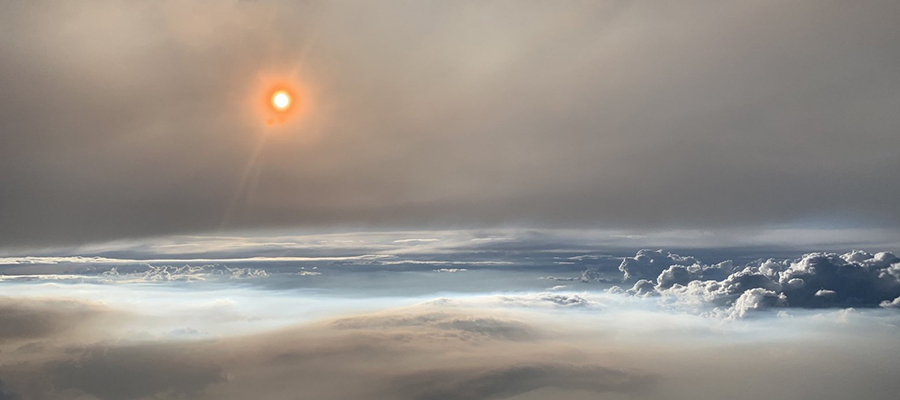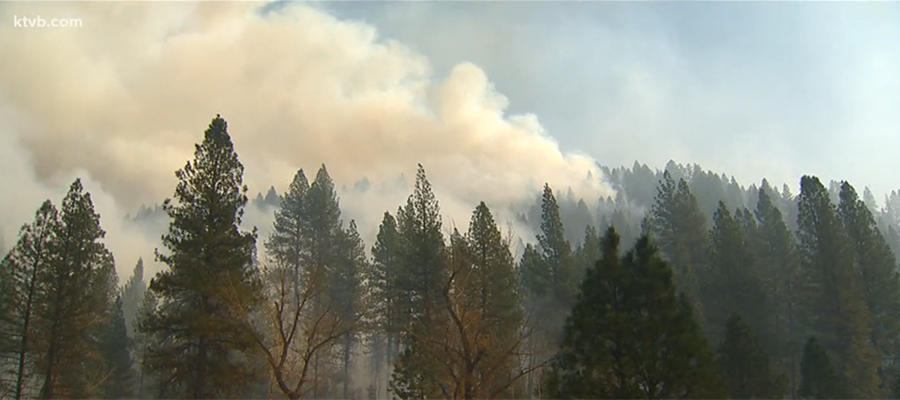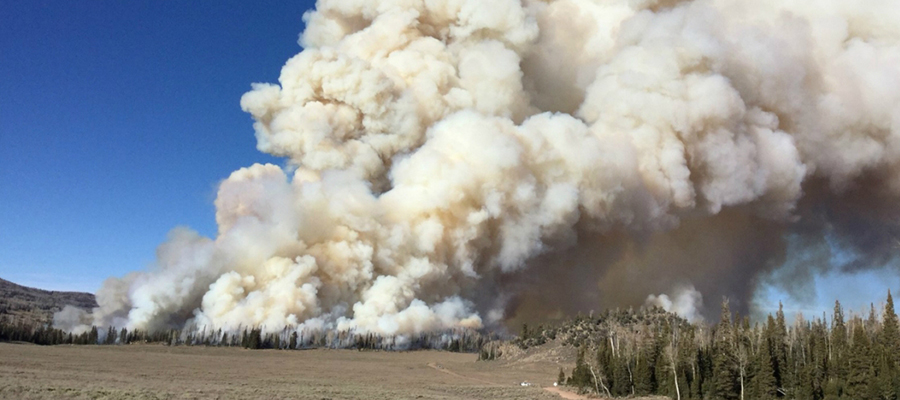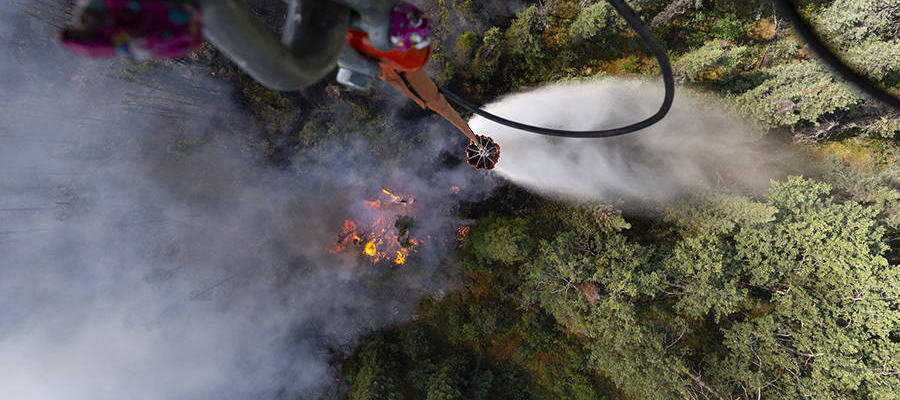Where There's Smoke
SLATE What It's Like Series, 4 November 2023
NOAA CSL's Carsten Warneke tells us what it's like to fly through a 'monster' plume of wildfire smoke. Read More
Wildfires Blast Smoke Corkscrews to the Top of the Atmosphere
Scientific American, 14 December 2020
Record-breaking blazes in Australia spewed as many particles into the sky as a volcanic eruption. Read More
The Effects of Massive Wildfires Can Reach the Stratosphere and Linger for Months
The Wall Street Journal, 16 November 2020
Australian smoke plumes created an ozone-layer hole, but the extent of damage from such novel weather events remains unclear. Read More
The Hidden Toll of Wildfires
Scientific American, March 2020
As wildfires worsen globally, an aerial campaign seeks to understand the effects of biomass smoke on human health. Read More
Firing Up Climate Models
Eos Earth & Space Science News, 27 January 2020
Scientists are working to incorporate wildfire data into climate models, resolving hindrances related to scale, speed, and the complex feedbacks between the climate and wildfire emissions. Read More
What Is Left in the Air After a Wildfire Depends on Exactly What Burned
Eos Earth & Space Science News, 23 January 2020
Forecasting air quality after a wildfire is improving, thanks to more-refined models that measure the biomass going into the blaze and the emissions coming out. Read More
Flying Through Fire With a Notepad and a Prayer
The New York Times, 22 November 2019
When I learned of a scientific mission to study wildfire smoke by flying through fires on a jet plane, I immediately asked to join the trip. – NY Times journalist Kendra Pierre-Louis Read More
What It's Like to Work in a Flying Smoke Laboratory
Gizmodo, 30 October 2019
Most scientists' labs don't fly. Most scientists' labs are also not packed in the interior of a DC-8 jet doing loopy maneuvers at low altitudes. This joint NASA and NOAA mission, though, is not a typical science lab. And it's not doing typical experiments. Read More
A Forecast for a Warming World: Learn to Live With Fire
The New York Times, 24 October 2019
All that is happening after three straight years of record-breaking fires that researchers say are likely to continue in a warming world and which raise an important question: How to live in an ecosystem that is primed to burn? Read More
Testing the effect of wildfires on the environment
KSNW 3 News, 22 August 2019
Scientists are working on answering how wildfires effect air quality and the environment. View More
NASA, NOAA using Salina airport as base for cross-country study on wildfires
KWCH 12 News, 21 August 2019
NASA and NOAA are spending the next two weeks in Salina, researching how wildfires and agricultural burns impact air quality, weather and climate. Read More
NASA in Salina to study impact of cross-country fires on air quality
Salina Journal, 20 August 2019
After four weeks in Boise, the NASA and NOAA FIREX-AQ research project will spend the next two and a half weeks in Salina exploring trace gasses and aerosol in smoke. Read More
FIREX-AQ Opens in Salina
KSAL.com, 20 August 2019
A massive joint collaboration studying the effects of fire and smoke on the earth and its inhabitants set up shop officially. Hundreds of scientists and crew members with FIREX-AQ, a joint mission between NASA and NOAA, descended upon Salina to open up a new branch of research. Read More
Boise-Based NASA/NOAA Mission Studies Wildfire Smoke To Improve Air Quality Prediction Models
Boise State Public Radio, 19 August 2019
Thick smoke from summertime wildfires can present major health risks. Prediction models help locals prepare for poor air quality to come, but the data behind those models is not as conclusive as we might think. Read More
Rare 'fire cloud' looks otherworldly in photo snapped from NASA's flying lab
NBC News MACH, 17 August 2019
New research on the clouds aims to improve forecasts of weather and air quality. You've seen billowy cumulus clouds and wispy cirrus clouds, but odds are you're not too familiar with fire clouds. Read More
NASA Made a Rare Flight Right Through a Thundercloud Formed by a Wildfire
VICE News, 16 August 2019
For years, Naval Research Laboratory meteorologist David Peterson has been obsessed with one of Earth's rarest atmospheric spectacles: thunderclouds formed by raging wildfires. Last week, he became one of the only people on Earth to fly straight through one. Read More
Flying through a Fire Cloud
NASA Earth Observatory, 13 August 2019
Atmospheric scientists regularly take note when satellites detect thunderheads rising above columns of wildfire smoke. These "fire clouds" are caused when fires loft enough heat and moisture into the atmosphere to produce thunderstorms. Read More
Washington wildfire smoke triggered a thunderstorm – and NASA researchers flew through it.
The Seattle Times, 11 August 2019
Wildfire smoke from the Williams Flats fire, burning on the Colville Indian Reservation, triggered a thunderstorm, and for one of the only times ever, scientists were able to fly through its clouds, photograph the phenomenon from a jet and take measurements from inside. Read More
Black Carbon Lofts Wildfire Smoke High into the Stratosphere to Form a Persistent Plume
NOAA Research / Cooperative Institute for Research in Environmental Sciences (CIRES) News, 8 August 2019
Analysis of massive 2017 cloud of wildfire smoke will help calibrate climate models, including modeling of nuclear winter and geoengineering. Read More
Just how bad are wildfires on our health? A high-tech lab will fly into smoke to find out
Idaho Statesman, 2 August 2019
Extreme Western wildfires lead to poor air quality close to the fires and far away, an increasing human health concern. Now, a high-tech flying science lab will fly directly over the fires to find out exactly what dangers lurk in the smoke. Read More
Unique flying lab studies how smoke travels, what it does to our bodies
Denver 7 News, 24 July 2019
Scientists have long warned of the effects of global warming and the possibility of more intense wildfires that burn for longer periods of time. Now, a new team of researchers is hoping to get a better understanding of how the smoke travels and what the tiniest particles could be doing to our lungs. Read More
Feds Launch Mission to Study Effects of Wildfire Smoke Health & Climate
Courthouse News Service, 23 July 2019
Boise – Mission scientists and program managers from NASA and NOAA kicked off their joint field campaign to study how U.S. wildfires and agricultural fires affect air quality and climate. Read More
NASA brings planes to Boise to study Idaho wildfire smoke
KTVB News, 23 July 2019
Scientists from NASA and NOAA are in Boise to study the smoke from our wildfires. Crews brought two aircraft they plan to fly over several Idaho wildfires in the next couple days. Read More
Flying Laboratory Studies Impact of Smoke and Fire
Spectrum News 1 LA - West, 23 July 2019
On the outside, it looks like an airplane, but on the inside it is a flying laboratory. NASA and NOAA have teamed up to lead a joint campaign called FIREX-AQ. Read More
Where there's fire, there's smoke – and secrets for science to uncover
NOAA, 22 July 2019
Hundreds of scientists embark on mission aimed at improving air quality forecasts. Read More
Tracking Smoke From Fires to Improve Air Quality Forecasting
NASA, 22 July 2019
NASA's DC-8 flying laboratory took to the skies to kick off a two-month investigation into the life cycles of smoke from fires in the United States. The goal is to better understand smoke impact on weather and climate and provide information that will lead to improved air quality forecasting. Read More
Firing up an air pollution problem
Chemistry World, 22 July 2019
Wild fires adversely affect air quality nearby and far beyond. Read More
Alaska Chokes on Wildfires as Heat Waves Dry Out the Arctic
Inside Climate News, 11 July 2019
Fires are spreading farther north, burning more intensely and starting earlier, in line with what scientists have warned would happen with climate change. Read More
Boulder Scientists Help Launch A Landmark Wildfire Smoke Study
Colorado Public Radio News, 8 July 2019
Even as climate changes spurs more wildfires, our knowledge of how their smoke impacts our health is still limited. Listen Now
NASA Project Analyzes Wildfire Smoke
NBC Los Angeles News, 2 July 2019
Scientists hope to find what parts of wildfire smoke are most carcinogenic and toxic. Watch Now
Summer of sooty skies: Wildfires are causing chronic smoke exposure, premature death
Associated Press, 25 June 2019
Climate change in the Western U.S. means more intense and frequent wildfires churning out waves of smoke that scientists say will sweep across the continent to affect tens of millions of people and cause a spike in premature deaths. Read More
Where there's smoke, there's research
Antelope Valley Press, 24 June 2019
When large wildfires hit, it is common these days to see satellite images of the smoke plumes as they travel hundreds, even thousands of miles from the fire itself. Those rivers of smoke will be the subject of a joint research project with NASA and NOAA this summer that will take a closer look at the smoke, its chemistry and how it changes and affects air quality and ultimately public health. Read More
These scientists are setting a forest on fire – and studying it with drones
Nature, 28 May 2019
Data from the blaze in Utah could improve models of how wildfire smoke spreads. Read More
Let's Talk - NOAA
Let's Talk with Mark Koebrich, 1 May 2019
On this episode, journalist Mark Koebrich talks with NOAA research scientists in Boulder, CO who help us better understand the many facets of our planet's weather, climate, and our sun. NOAA ESRL CSD's Carsten Warneke and Shuka Schwarz discuss fire emissions and smoke, and the FIREX-AQ 2019 summer research project. This program airs on the local government access channels in Arvada and Lakewood on Comcast 8, and can be viewed on YouTube (City of Arvada): Let's Talk - NOAA.
Fire-Induced Storms: A New Danger from the Rise in Wildfires
Yale Environment 360, 24 January 2019
Scientists are tracking an increase in a little-known phenomenon in which intense wildfires can spawn their own thunderstorms, known as pyroCbs. Lightning from these storms can spark additional blazes far away and send plumes of smoke and aerosols into the stratosphere. Read More
Scientists fly through plumes of wildfire smoke to unravel its mysteries
The Verge, 21 November 2018
What happens to smoke after it is lofted into the air and starts interacting with air currents and weather is far more complicated than it might appear. Read More
Major Campaign Aims to Unravel Exactly What Is in Wildfire Smoke
Scientific American, 13 November 2018
Airplanes and a planned burn of forest area will help identify the thousands of chemicals in smoke plumes. The goal is to better understand the health, climate and weather impacts of the nation’s increasing volume of wildfires. Read More
NASA assists in efforts to contain California wildfires
Goespatial World, 30 August 2018
An effort by multiple NASA centers to assist with the California wildfires included capturing satellite data of the smoke plumes and aircraft flights over burned areas to collect information for recovery planning. Read More
Wildfire temperatures key to better understanding air quality
Phys.org, 13 August 2018
Wildfire emissions, which can be transported over long distances, can be toxic and contribute to the formation of secondary pollutants such as ozone and fine particles in the atmosphere. Those emissions affect human health and the environment, so scientists want to know what's in wildfire smoke. Read More
































